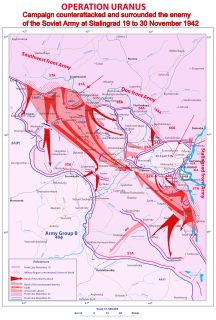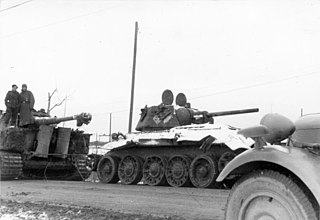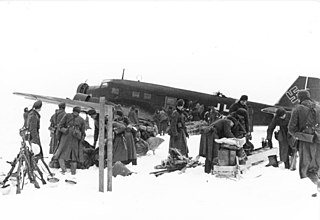Related Research Articles

The Battle of Stalingrad was a major battle on the Eastern Front of World War II where Nazi Germany and its allies unsuccessfully fought the Soviet Union for control of the city of Stalingrad in Southern Russia. The battle was marked by fierce close-quarters combat and direct assaults on civilians in air raids. The Battle of Stalingrad was the deadliest battle to take place during the Second World War and is one of the bloodiest battles in the history of warfare, with an estimated 2 million total casualties. Today, the Battle of Stalingrad is universally regarded as the turning point in the European Theatre of war, as it forced the Oberkommando der Wehrmacht to withdraw considerable military forces from other areas in occupied Europe to replace German losses on the Eastern Front. The victory at Stalingrad energized the Red Army and shifted the balance of power in the favour of the Soviets.

Operation Uranus was the codename of the Soviet Red Army's 19–23 November 1942 strategic operation on the Eastern Front of World War II which led to the encirclement of Axis forces in the vicinity of Stalingrad: the German Sixth Army, the Third and Fourth Romanian armies, and portions of the German Fourth Panzer Army. The Red Army carried out the operation at roughly the midpoint of the five-month long Battle of Stalingrad, aiming to destroy German forces in and around Stalingrad. Planning for Operation Uranus had commenced in September 1942, and developed simultaneously with plans to envelop and destroy German Army Group Center and German forces in the Caucasus. The Red Army took advantage of the German army's poor preparations for winter, and the fact that its forces in the southern Soviet Union were overstretched near Stalingrad, using weaker Romanian troops to guard their flanks; the offensive's starting points were established along the section of the front directly opposite Romanian forces. These Axis armies lacked heavy equipment to deal with Soviet armor.

Army Group South was the name of three German Army Groups during World War II.

Nikolai Fyodorovich Vatutin was a Soviet military commander during World War II. Vatutin was responsible for many Red Army operations in Ukraine as commander of the Southwestern Front, and the Voronezh Front during the Battle of Kursk. During the Soviet offensive to retake right-bank Ukraine, Vatutin led the 1st Ukrainian Front, responsible for the Red Army's offensives to the west and south-west of Kyiv and the eventual liberation of the city.

Kurt Zeitzler was a Chief of the Army General Staff in the Wehrmacht of Nazi Germany during World War II.

The 6th Army was a field army unit of the German Wehrmacht during World War II (1939–1945). It was widely remembered for being the most highly decorated German army unit until its defeat by the Red Army at the Battle of Stalingrad in the winter of 1942–1943. It also acquired a reputation for the war crimes that it committed under the command of Field Marshal Walther von Reichenau during Operation Barbarossa.

Operation Winter Storm, a German offensive in December 1942 during World War II, involved the German 4th Panzer Army failing to break the Soviet encirclement of the German 6th Army during the Battle of Stalingrad.

Case Blue was the German Armed Forces' name for its plan for the 1942 strategic summer offensive in southern Russia between 28 June and 24 November 1942, during World War II. The objective was to capture the oil fields of Baku, Azerbaijan SSR for two purposes: to enable the Germans to re-supply their low fuel stock and also to deny their use to the Soviet Union, thereby bringing about the complete collapse of the Soviet war effort.
Alexander Edler von Daniels was a German general in the Wehrmacht during World War II who fought in the Battle of Stalingrad.

Operation Saturn, revised as Operation Little Saturn, was a Red Army operation on the Eastern Front of World War II that led to battles in the North Caucasus and Donets Basin regions of the Soviet Union from December 1942 to February 1943.

The 2nd Guards Army was a field army of the Soviet Union's Red Army that fought in World War II, most notably at Stalingrad.

The Demyansk Pocket was the name given to the pocket of German troops encircled by the Red Army around Demyansk, south of Leningrad, during World War II's Eastern Front. The pocket existed mainly from 8 February to 21 April 1942.
The 4th Mechanized Corps was a formation in the Soviet Red Army during the Second World War.

Two Romanian armies, the Third and the Fourth, were involved in the Battle of Stalingrad, helping to protect the northern and southern flanks respectively, of the German 6th Army as it tried to conquer the city of Stalingrad defended by the Soviet Red Army in mid to late 1942. Overpowered and poorly equipped, these forces were unable to stop the Soviet November offensive, which punched through both flanks and left the 6th Army encircled in Stalingrad. The Romanians suffered enormous losses, which effectively ended their offensive capability on the Eastern Front for the remainder of the war.

The Hungarian Second Army was one of three field armies (hadsereg) raised by the Kingdom of Hungary which saw action during World War II. All three armies were formed on March 1, 1940. The Second Army was the best-equipped Hungarian formation at the beginning of the war, but was virtually eliminated as an effective fighting unit by overwhelming Soviet force during the Battle of Stalingrad, suffering 84% casualties. Towards the end of the war, a reformed Second Army fought more successfully at the Battle of Debrecen, but, during the ensuing Siege of Budapest, it was destroyed completely and absorbed into the Hungarian Third Army.

The 51st Army was a field army of the Red Army that saw action against the Germans in World War II on both the southern and northern sectors of the front. The army participated in the Battle of the Kerch Peninsula between December 1941 and January 1942; it was destroyed in May 1942 with other Soviet forces when the Wehrmacht launched an operation to dislodge them from the peninsula. The army fought in the Battle of Stalingrad during the winter of 1942–43, helping to defeat German relief attempts. From late 1944 to the end of the war, the army fought in the final cutting-off of German forces in the Courland area next to the Baltic. Inactivated in 1945, the army was activated again in 1977 to secure Sakhalin and the Kuril Islands. Following the dissolution of the Soviet Union, the army continued in existence as a component of the Russian Ground Forces. The army was active during two periods from 1941 until 1997.

Arthur Schmidt was an officer in the German military from 1914 to 1943. He attained the rank of Generalleutnant during World War II, and is best known for his role as the Sixth Army's chief of staff in the Battle of Stalingrad in 1942–43, during the final stages of which he became its de facto commander, playing a large role in executing Hitler's order that it stand firm despite being encircled by the Red Army. He was a prisoner of war in the Soviet Union for twelve years, and was released following West German chancellor Konrad Adenauer's visit to Moscow in 1955.
Events in the year 1942 in Germany.
The 422nd Rifle Division was formed for the first time as a standard Red Army rifle division late in 1941, after the Soviet winter counteroffensive had begun, but was soon re-designated. A second formation began in March, 1942, again in the far east of Siberia, until July, after which it was moved west to join the reserves of Stalingrad Front in August. It was the highest-numbered rifle division to see active service in the front lines during the Great Patriotic War. Over the course of the next six months, the division distinguished itself in both defensive and offensive fighting and earned its re-designation as the 81st Guards Rifle Division on the first day of March, 1943. The 422nd was never reformed.
References
- ↑ Adam, Wilhelm; Ruhle, Otto (2015). With Paulus at Stalingrad. Translated by Tony Le Tissier. Pen and Sword Books Ltd. p. 137. ISBN 9781473833869.
- ↑ "Battle of Stalingrad: Operation Winter Tempest". World War II Magazine. 12 June 2006. Retrieved 2013-12-31.